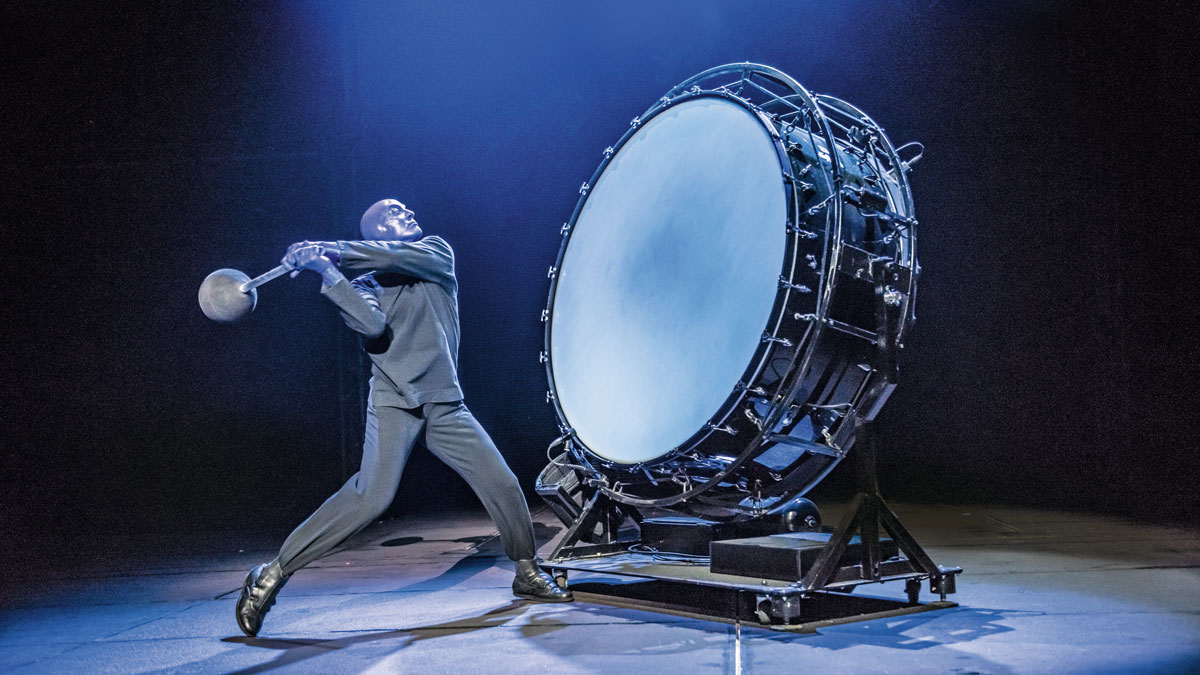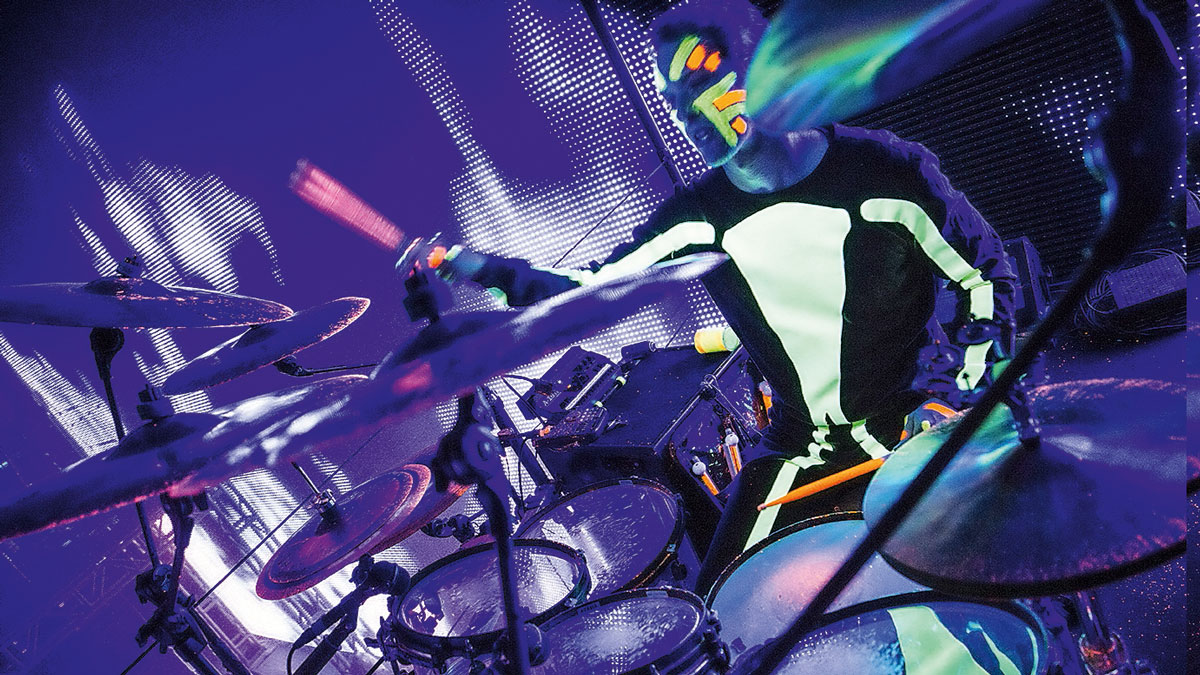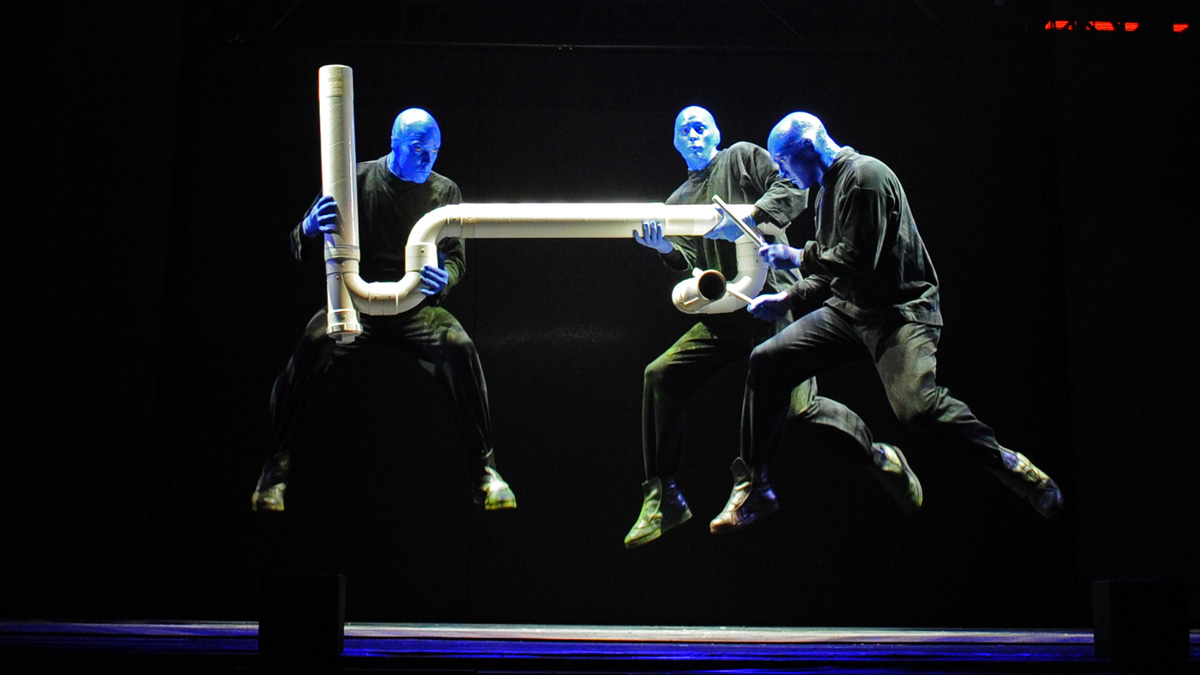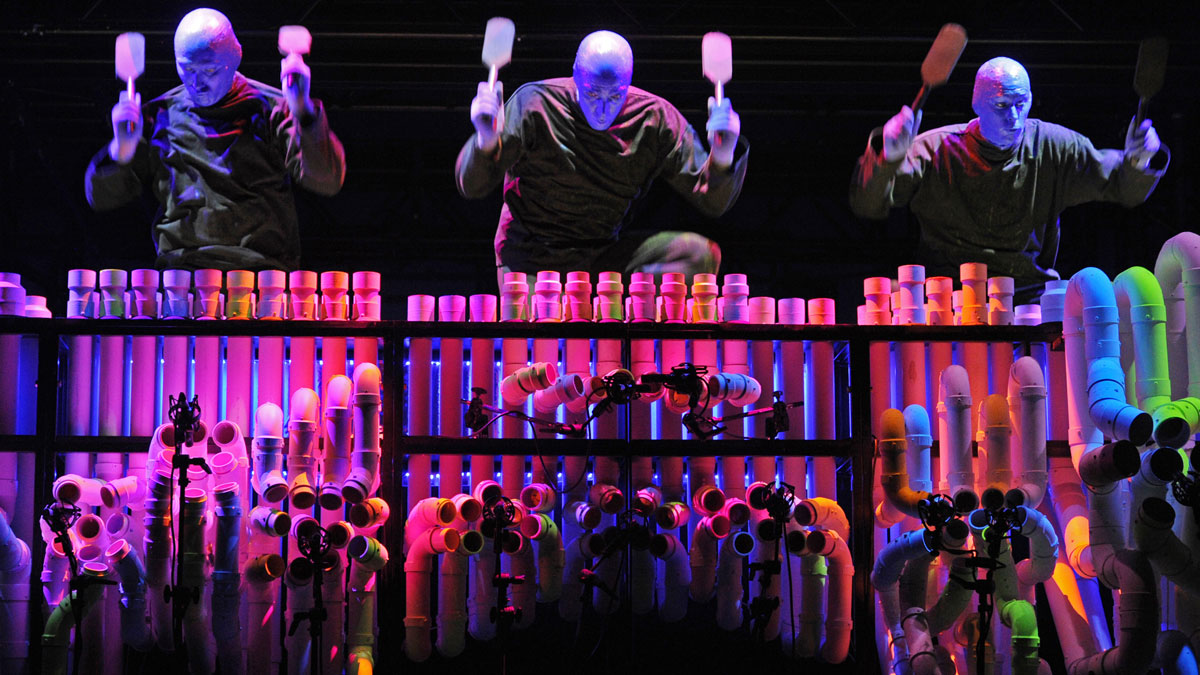Steve Ballstadt and Andrew Schneider on the insane world of the Blue Man Group
Drums, drums, drums… and all that blue pain

The ever so slightly crazy world of the Blue Man Group
Since launching 25 years ago, the Blue Man Group show has become a global phenomenon, with the paint-clad trio rocketing to genuine pop culture icon status. Not bad for a bunch of blue dudes banging out rhythms on just about anything they can get their hands on.
This success has taken the show around the world, with globe-spanning tours and residencies across the US, Europe and beyond. It’s also spawned three studio albums, the latest of which, appropriately entitled Three, was released earlier this year.
It’s a record that features a baffling array of drums. Seriously, a more percussion-packed album you will not find. Two men charged with the task of turning a barrage of beats into a cohesive record were Steve Ballstadt and Andrew Schneider.
Steve has been part of the Blue Man universe since 2005, first as the show’s kit player before morphing into his current role as an associate music director and musical director. Andrew, meanwhile, has been involved in all three Blue Man albums and served as producer, engineer and mixer for Three.
So, when we spoke to these Blue Men, we wanted to find out how on earth they captured the show’s bonkers energy and non-stop drumming assault on their superb latest album.

Blue Man beginnings
Tell us about your drumming background...
Steve: “I started off on piano and then like most hyperactive boys I moved over to something louder. I’ve been playing since I was 13. I was in bands all through high school and I never stopped playing. I was touring and recording and eventually a friend gave me a heads-up of the Blue Man audition back in 2005.”
What was the audition process like?
Steve: “It was kind of intense. I had never done any serious auditions before. The artists I had been recording with, I had got those gigs through friends rather than a hardcore audition process with a bunch of people staring at you.
“Everyone else auditioning for Blue Man had been through the audition process at least twice and had an understanding of the music whereas I kind of stepped in at the last second and had no real idea of what was going on or what was expected of me. The guys played through a song and then everybody got a chance to play along with them.
“You were basically asked to repeat something that you had heard once before, it was quite daunting. The music that they play in the audition is your first exposure to the vocabulary of Blue Man music. You don’t play that style of music outside of Blue Man. It was very daunting, but a lot of fun.”
The music that they play in the audition is your first exposure to the vocabulary of Blue Man music. You don’t play that style of music outside of Blue Man.
Andrew, how did you become involved?
Andrew: “I have a long history with a lot of the albums with Blue Man. The first album they did, audio, I engineered that. I was friends with the producer of the first two records so he brought me in to engineer the first one and mix the second record.
“Then there was a long gap between records. The music for Audio came about after the show had been around for about 10 years so there was 10 years of material. Because of the 13-year gap between record two and three we had 13 years of material that had organically been produced in that time for the shows and performances, so it seemed like it was time to work on a new record. For Three I wore all three hats. I was one of two producers, I mixed the record and I co-engineered the record.”

Hitting the studio
How did the music come together. Was it purely based on material from the live show?
Andrew: “With Audio the music on that album was inspired by the music in the show but it took on its own form on the record. The same thing happened with Three. We had some starting places from a lot of the material but we were also really eager to explore.
“We did heavy demo sessions before going into the studio, about three or four months of demoing. We also demo’d while we were recording. As we recorded songs four, five and six we were demoing seven, eight and nine. There was writing happening in the studio during the recording as well.”
There’s no planned-out way that we write material, every song has its own process.
How did the new material come together?
Andrew: “There’s no planned-out way that we write material, every song has its own process. Snorkelbone was inspired by the instruments and everything else came around that.
“The song Hex Suit, there was an idea of visually using these light suits that the Blue Man Group wear and that created a lot of work with electronic sounds. From there the idea was to craft music around that.
“The song Vortex just had a demo drum beat that was an electronic demo with all of these bad edits. When it came to record it we decided we wanted to learn the part so that the hi-hat would mimic the bad edits that we had on the electronic demo. The process was always creative but it was wildly different from song to song.”

Preventing a train wreck
With so many drummers and percussionists, how do you keep it all together?
Steve: “Andrew is an expert at that! We could have five drummers in the room playing at the same time, all of us miked up and all of us with our own sonic space. The piece needs to breathe and it can get crowded pretty quickly.”
Andrew: “They throw everything in and then leave, and I have to cut it back [laughs]. No, I’m joking.”
Seriously, this could easily be a train wreck...
Steve: “It seriously is a monumental task coming up with an instrumental album that stays true to the aesthetic and is interesting. Andrew has the hardest task of everyone. We’ve got so many people with so many ideas.
“He’s got all of these instruments and he has to figure out how to get a decent tone out of them, where he’s going to place them and in what environment. Then you’ve got multiple people playing at the same time and it’s all on Andrew to make it sound good.”
We could have five drummers in the room playing at the same time, all of us miked up and all of us with our own sonic space. The piece needs to breathe and it can get crowded pretty quickly.
Andrew: “The way I see a lot of the Blue Man music and the drums specifically, it’s drums but it feels like the melody to me. You have to find the melody and the emotion that is driving each song and often if that is the drums you have to find the space to let it breathe.
“The Forge is a song where we had two drum kits, a percussion rig and three sets of drum tracks with five people playing toms and snares. That was one we were subtracting from. At times the bombast of having all that stuff is incredible, but you need to have the melody of those drum parts jump through.”
How do you juggle all of that, is the material diligently charted out?
Andrew: “When it gets as deep as The Forge with 20 people playing toms, that stuff is pretty written-out. But the initial work on the kits, there’s a lot of writing ahead of time, then when it comes time to record, it’s not locked in so tight that there isn’t room to explore.”
Rich is a teacher, one time Rhythm staff writer and experienced freelance journalist who has interviewed countless revered musicians, engineers, producers and stars for the our world-leading music making portfolio, including such titles as Rhythm, Total Guitar, Guitarist, Guitar World, and MusicRadar. His victims include such luminaries as Ice T, Mark Guilani and Jamie Oliver (the drumming one).
